Gotthard: a ‘connection between two cultures’

The Gotthard base tunnel opens for business on Sunday. Trains will run through the Gotthard mountain in just 20 minutes, but passengers will miss out on the sights along the historic route. Historian and railway expert Kilian T. Elsasser filled us in on exactly what we’ll be missing out on.
swissinfo.ch: What makes this stretch of railway between Erstfeld, canton Uri, and Bodio, canton Ticino, so special?
Kilian T. Elsasser: It’s simply an extraordinarily exciting journey through the untamed Alps. The route is very closely tied to the Swiss identity. It’s dripping with history, you could say.
swissinfo.ch: What’s the significance of the central North-South axis no longer going over this historic route?
K.T.E.: The new tunnel is a feat of engineering. As a Swiss, I’m proud. On the other hand, there’s a touch of bitterness that we now only need this route for local journeys and pleasure trips.
swissinfo.ch: Let’s imagine we’re travelling from north to south. The northern entrance to the Gotthard tunnel is in Erstfeld. Is it worth seeing?
K.T.E.: Erstfeld was a small village; it was the Gotthard railway that put it on the map. It became the place where locomotives were serviced and then attached so that heavy trains could travel over the Gotthard. In the 19th century it was a real boomtown. This is where one of the first Reformed churches in central Switzerland was built. It’s a part of history.

More
The lost world of the Gotthard
swissinfo.ch: A section of the route going into the tunnel goes past a village called Gurtnellen, where there are frequent avalanches that block the line. Does nature often get in the way like this?
K.T.E: It was a human triumph to be able to build a railway line here. But humankind will always have to fight against nature, whether it’s storms, falling rocks or landslides. It was, and still is, a constant struggle to keep the line safely in service. A great deal of maintenance is required.
swissinfo.ch: On the way, travellers will spy a little church out of the window in a town called Wassen. In fact they’ll see it from three different perspectives thanks to the way the tunnels twist and turn cutting in and out of the rock as the railway line climbs. When did this church start to attract attention?
K.T.E.: In the 19th century, the Gotthard railway was the most important tourist attraction in Switzerland. Every tourist wanted to go on it and every tour guide mentioned it. The Swiss connection to the church really began in earnest in the 1960s and 1970s, when the comedian Emil Steinberger made a comedy sketch about these types of churches.
swissinfo.ch: Many people have seen the church, but not so many have been inside.
K.T.E.: As far as I know, very few have seen the church from the inside. It’s a very pretty Baroque church. The change in perspective when people look at it from the train is something of a fascination, because it’s difficult to get your bearings. I was with an Indian visitor once who thought he was hallucinating because he saw the church three times.
swissinfo.ch: And what about the village of Göschenen – what are people missing here?
K.T.E.: Göschenen is not just a good viewpoint for hikers, it’s also an interesting place with a lot of history. National history was made here with the building of the Gotthard tunnel. The old Gotthard pass and tollgates are also wonderful reminders of the past.
swissinfo.ch: Our journey continues through the “old” Gotthard tunnel to Airolo in Ticino. Could you say this more than just a tunnel?
K.T.E.: Definitely. It’s a connection between two cultures – German and Italian. It bonds Switzerland together. It’s also a symbol of how small Switzerland is. After just 15km [nine miles – the length of the tunnel) you feel like you’re in a different country – it’s fascinating.
swissinfo.ch: A bit further along, the train winds its way through the Leventina valley. How difficult was it to build a railway line through this narrow mountain valley in the 19th century?
K.T.E.: It was an enormous challenge. We often hear about the 200 people who lost their lives while building the Gotthard tunnel. But just as many died making the approach to the tunnel. Overcoming the Piottina and Biaschina gorges with helical (spiral) tunnels was difficult. It’s still worthwhile to see this area today.
swissinfo.ch: What other places stand out in the Leventina valley?
K.T.E.: The run-down hotels in front of Faido station, for example, from when Faido was a health resort. They’re a piece of tourism history. Giornico with its Romanesque churches is also very nice. You see the first grapevines here and really feel like you’ve arrived in Ticino, in the south.
swissinfo.ch: You’re in favour of an application to make the Gotthard railway a UNESCO World Heritage Site. Why is that?
K.T.E.: The route is a unique technical monument that’s also in very good condition. You can even see technical development in it. This railway line shaped Switzerland like no other structure in the country. The UNESCO label would be a big attraction to this area.
A seat with a view
When the Gotthard Base Tunnel comes into full operation on December 11, the rail service running over the Gotthard’s more scenic route will change. There will no longer be a direct train running from Zurich or Basel to Ticino via the “panoramic route”. A change in Erstfeld will be introduced. “Regio-Express” trains (which stop more frequently than fast city to city trains) will run every hour between Erstfeld and Bellinzona, although passengers will also be able to get a faster connection from these two stops.
At times when there is high demand, one-off semi-fast trains will run from Basel and Zurich to Göschenen. From April to October a direct train will run on weekends and holidays from Zurich straight to Bellinzona over the scenic Gotthard route. A new “Gotthard Panorama Express” with extra-large windows in first-class coaches will run from Easter until the end of October.
Kilian T. Elsasser
The 60-year-old historian and museum expert worked from 1992 to 2004 as a curator of rail transport at the Museum of Transport in Lucerne. In 2004 he founded the “Museumsfabrik”, a company that advises museums. He recently published ‘Drei Weltrekorde am Gotthard‘ (Three World Records on the Gotthard), a book with journalist Alexander Grass, published in 2016.
Translated from German by Jo Fahy

In compliance with the JTI standards
More: SWI swissinfo.ch certified by the Journalism Trust Initiative












You can find an overview of ongoing debates with our journalists here . Please join us!
If you want to start a conversation about a topic raised in this article or want to report factual errors, email us at english@swissinfo.ch.